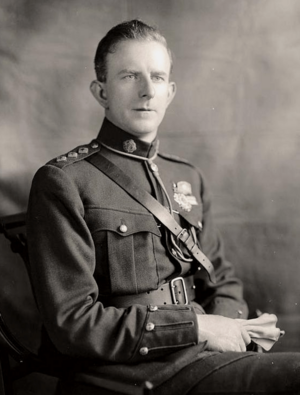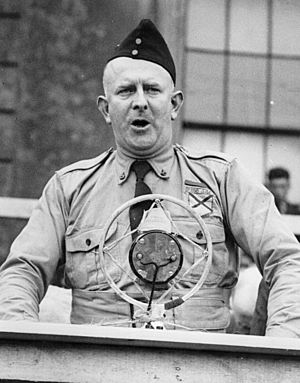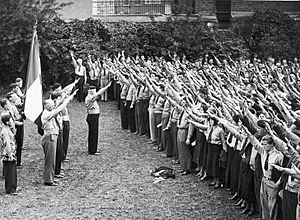Eoin O'Duffy facts for kids
Quick facts for kids
Eoin O'Duffy
|
|
|---|---|

O'Duffy in Blueshirt attire, c. 1934
|
|
| Leader of Fine Gael | |
| In office 4 May 1933 – 16 June 1934 |
|
| Preceded by | New office |
| Succeeded by | W. T. Cosgrave |
| Garda Commissioner | |
| In office 30 September 1922 – February 1933 |
|
| Preceded by | Michael Staines |
| Succeeded by | Eamon Broy |
| Teachta Dála | |
| In office May 1921 – August 1923 |
|
| Constituency | Monaghan |
| Personal details | |
| Born |
Owen Duffy
28 January 1890 Lough Egish, County Monaghan, Ireland |
| Died | 30 November 1944 (aged 54) Dublin, Ireland |
| Resting place | Glasnevin Cemetery, Dublin, Ireland |
| Political party | |
| Military service | |
| Allegiance | |
| Branch |
|
| Years of service |
|
| Rank |
|
| Battles/wars | |
Eoin O'Duffy (born Owen Duffy; 28 January 1890 – 30 November 1944) was an important Irish leader. He was a military commander, a police chief, and a political figure. O'Duffy led a part of the Irish Republican Army (IRA) during the Irish War of Independence. He later became the Chief of Staff of the IRA in 1922.
After the Anglo-Irish Treaty, he joined the side that supported the treaty. He became a general in the National Army during the Irish Civil War. In 1923, he became the second leader of the Garda Síochána, which is Ireland's police force.
In the 1930s, O'Duffy became interested in certain political movements popular in Europe at the time. In 1933, he took charge of a group called the Army Comrades Association, also known as the Blueshirts. When the Blueshirts joined with other political parties to form Fine Gael, O'Duffy became its first leader. Later, he led a group of Irish volunteers, called the Irish Brigade, to fight in the Spanish Civil War.
O'Duffy was also very active in sports. He was involved with the Gaelic Athletic Association and the Irish Olympic Council.
Contents
Early Life and Career
Eoin O'Duffy was born Owen Duffy on 28 January 1890. His family lived in Lough Egish, near Castleblayney, County Monaghan, Ireland. He was the youngest of seven children. His family was not wealthy and worked hard on their small farm.
O'Duffy went to Laggan national school. He also attended night classes to learn more about the Gaelic Revival. This was a movement to promote Irish culture and language. When he was 12, his mother passed away, which greatly affected him.
In 1909, O'Duffy started a career as a clerk in the county surveyor's office in Monaghan. He later became an engineer.
His Role in Sports
O'Duffy was a key person in the Gaelic Athletic Association (GAA) in Ulster. He became the secretary of the Ulster Provincial Council in 1912. From 1921 to 1934, he served as the Treasurer of the GAA Ulster Council. His work helped develop the GAA in Ulster. A part of the main stadium in Clones, County Monaghan, called the O'Duffy Terrace, is named after him.
He was also involved in other sports. He was the President of the Irish Amateur Handball Association from 1926 to 1934. He also led the National Athletic and Cycling Association and the Irish Olympic Council.
O'Duffy believed that sports helped young people develop good habits. He said that sport teaches "self-control" and "self-denial." He thought it promoted "the cleanest and most wholesome of the instincts of youth."
Joining the Irish Republican Army
In 1917, O'Duffy joined the Irish Volunteers. This group later became the Irish Republican Army (IRA). He quickly moved up in the ranks during the Irish War of Independence. He started as a Section Commander and became a Brigadier in 1919.
Michael Collins, a famous Irish leader, noticed O'Duffy. Collins thought O'Duffy was "the best man in Ulster." O'Duffy's knowledge of Monaghan from his job and his involvement in the GAA helped him organize and recruit for the IRA.
In 1918, O'Duffy became a secretary for Sinn Féin in north Monaghan. He was arrested and held in Belfast Prison for a short time. After his release, he focused on building an intelligence network for his brigade.
On 15 February 1920, O'Duffy was involved in the first capture of a Royal Irish Constabulary (RIC) barracks by the IRA in Ballytrain, Monaghan. This event helped the IRA gain more members and affected the morale of the RIC. He was arrested again and went on a hunger strike before being released in June.
O'Duffy's brigade began taking weapons from homes. This caused more tension between different groups. He also supported the Belfast Boycott, which meant his group stopped goods from Belfast.
In 1921, O'Duffy became more determined in his actions. He increased attacks on British forces. He was made commander of the IRA's 2nd Northern Division. In May 1921, he was elected as a Sinn Féin representative (TD) for Monaghan. He was re-elected in 1922.
After a ceasefire with the British in July 1921, O'Duffy went to Belfast. He worked to keep the peace and protect Catholic areas. In January 1922, he became the IRA Chief of Staff. O'Duffy was known as the youngest general in Europe at that time.
Police Commissioner and Civil War General
In 1921, O'Duffy supported the Anglo-Irish Treaty. He believed it was a step towards an independent Irish republic. During the Irish Civil War, he served as a general in the National Army. He helped plan military actions for the pro-treaty side. He captured Limerick for the Free State in July 1922.
In September 1922, O'Duffy was appointed Garda Commissioner. This meant he was the head of the new Irish police force, the Garda Síochána. He resigned from the army to take on this role. O'Duffy was a very good organizer. He is given much credit for making the Gardaí a respected, non-political, and unarmed police force. He encouraged Garda members to join the Pioneer Total Abstinence Association, which promoted avoiding alcohol.
In February 1933, Éamon de Valera, the new leader of the government, removed O'Duffy from his position as Garda Commissioner. De Valera stated that O'Duffy might be biased due to his past political connections.
Leading the Blueshirts
In July 1933, O'Duffy became the leader of the Army Comrades Association. This group was formed to protect political meetings from being disrupted. O'Duffy was seen as a good choice to lead this group because he was charismatic and good at organizing.
O'Duffy changed the name of the movement to the National Guard. He admired the Italian leader Benito Mussolini. O'Duffy's group adopted symbols like the straight-arm salute and a blue uniform. Soon, they became known as the Blueshirts. O'Duffy started a newspaper called the Blueshirt. He promoted ideas like Irish unity and opposing foreign control.
In August 1933, the Blueshirts planned a parade in Dublin. This was seen as similar to a famous march in Italy. The government worried about a possible takeover. On 11 August, the parade was banned. On 22 August, the Blueshirts were declared an illegal organization. To get around this ban, they changed their name again to the League of Youth.
O'Duffy and some of his men also attended an international conference in 1934. There, he spoke against antisemitism, saying that Ireland had "no Jewish problem."
Fine Gael Party Leader
On 24 August 1933, the Blueshirts joined with other political parties to form Fine Gael. O'Duffy became the first leader of this new party. The Blueshirt movement, now called the Young Ireland Association, became the active part of the political party.
Fine Gael meetings were often attacked by members of the IRA. O'Duffy's visits to towns sometimes led to violence. In October 1933, O'Duffy was involved in disturbances in Tralee. The government used this violence to control Blueshirt activities. The Young Ireland Association was banned again.
O'Duffy proved to be a challenging leader. He was more of a soldier than a politician. He had strong nationalistic views. He also disagreed with his party on economic matters. His colleagues were concerned by the Blueshirts' use of violence and O'Duffy's connections with foreign groups.
After Fine Gael did not win as many local elections as O'Duffy had predicted in 1934, his influence weakened. He resigned from the party on 18 September 1934.
Spanish Civil War and Later Life
After leaving Fine Gael, O'Duffy tried to lead the Blueshirts as an independent group. However, the Blueshirts soon broke apart. In June 1935, O'Duffy started a new political party called the National Corporate Party.
The next year, he organized an Irish Brigade to fight in the Spanish Civil War. He wanted to help Francisco Franco because he believed it was a fight to defend Catholicism. About 700 of O'Duffy's followers went to Spain. However, they saw little fighting and returned home in June 1937.
O'Duffy wrote a book called Crusade in Spain (1938) about his experiences. He continued to be interested in politics and met with various figures. His health declined, and he passed away on 30 November 1944, at the age of 54. He received a state funeral and was buried in Glasnevin Cemetery.
Images for kids
See also
 In Spanish: Eoin O'Duffy para niños
In Spanish: Eoin O'Duffy para niños






